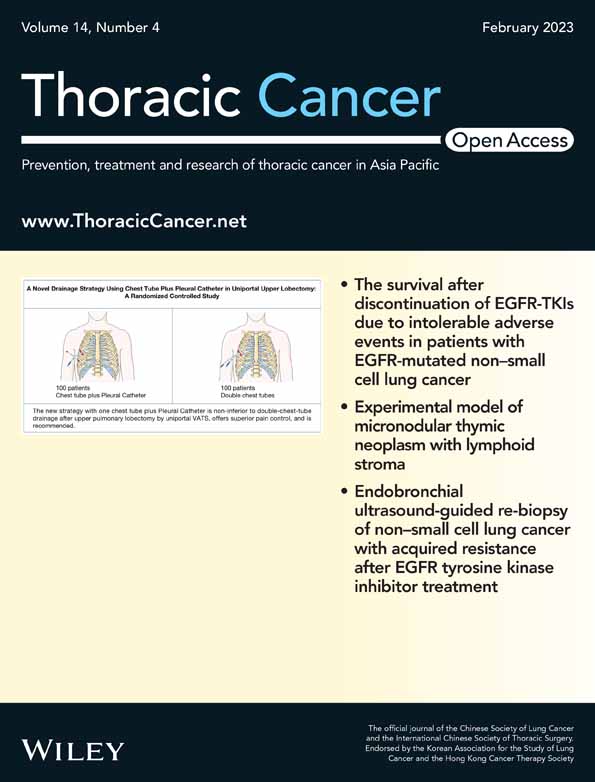LINC02323 facilitates development of lung squamous cell carcinoma by miRNA sponge and RBP dysregulation and links to poor prognosis
Funding information: Kaohsiung Medical University Chung-Ho Memorial Hospital, Grant/Award Numbers: KMUH-110-0R14, KMUH-110-0R17; Ministry of Science and Technology, Taiwan, Grant/Award Numbers: MOST 110-2314-B-037-124-MY3, MOST 110-2314-B-037-126-MY2
Abstract
Background
The poor outcome of patients with lung squamous cell carcinoma (LUSC) highlights the importance of the identification of novel effective prognostic markers and therapeutic targets. Long noncoding RNAs (lncRNAs) have generally been considered to serve important roles in tumorigenesis and the development of various types of cancer, including LUSC.
Methods
Here, we aimed to investigate the role of LINC02323 in LUSC and its potential mechanisms by performing comprehensive bioinformatic analyses.
Results
LINC02323 was elevated and positively associated with unfavorable prognosis of LUSC patients. LINC02323 exerted oncogenic function by competitively binding to miR-1343-3p and miR-6783-3p, thereby upregulating L1CAM expression. Indeed, we also determined that LINC02323 could interact with the RNA-binding protein DDX3X, which regulates various stages of RNA expression and processing.
Conclusion
Taken together, we identified that LINC02323 and its indirect target L1CAM can act as novel biomarkers for determining the prognosis of patients with LUSC and thus deserves further study.
INTRODUCTION
Lung cancer is the leading cause of tumor-related mortality worldwide.1 Non-small cell lung cancer (NSCLC), which accounts for more than 85% of all lung cancers, consists of two predominant subtypes: lung adenocarcinoma (LUAD) and lung squamous cell carcinoma (LUSC). The 5-year overall survival (OS) rate of advanced NSCLC has greatly improved due to the targeted therapies and immune checkpoint inhibitors.2, 3 However, these agents preferentially benefit patients with LUAD,5 and the current OS of LUSC remains 20%–30% less than that of LUAD.6-8 These differences in available therapeutic strategies and clinical outcomes result from different molecular patterns according to tumor genomic aberration or transcript alterations.4 Hence, elucidating the molecular mechanisms underlying tumorigenesis and progression might be conducive to developing more effective therapeutic targets for LUSC.
Noncoding RNAs (ncRNAs), especially microRNAs (miRNAs) and long noncoding RNAs (lncRNAs), contribute to various biological processes in cancer tumorigenesis and progression.5, 6 LncRNA with a length >200 nucleotides may be involved in more diverse and complex mechanisms for regulating the biogenetic process because of the longer sequences and more complex spatial structures compared with small RNAs.7, 8 LncRNAs interact with DNAs, RNAs, and proteins to participate in numerous physiological and pathological processes at the transcriptional, translational, and epigenetic levels and other mechanisms such as chromatin remodeling, cell cycle regulation, splicing regulation, mRNA degradation, and translational regulation.9, 10 Several lncRNAs are expressed abnormally in lung cancer, particularly in LUAD, where they may act as oncogenes or tumor suppressor genes, suggesting lncRNA as novel tumorigenic drivers in lung cancer. LncRNA H19 interacts with mutant-type p53 (R175H), leading to LUAD progression.11 LncRNA-MALAT1 promotes the spread and invasion of lung cancer by regulating the expressions of miR-124/STAT3 and miR-206/AKT.12 LINC00261 decreases hypoxia-induced tumor angiogenesis and its loss was associated with a poor prognosis for patients with LUAD.13 However, the relationship between lncRNAs and the progression of LUSC remained unclear.
Systemic biology and bioinformatic approaches can facilitate the understanding of the pathogenesis of LUSC and the identification of potential novel biomarkers and druggable targets.14-16 Many transcriptomic analyses and datasets of LUSC samples have been established. Nevertheless, compared with coding genes and microRNAs, the specific lncRNAs involved in the onset and development of LUSC remain unknown. The current study was designed to investigate LINC02323 expression (located between 545 253 and 102 592 425 on chromosome 14) and its prognostic value in LUSC. Our results showed that LINC02323 functioned as an oncogene in LUSC by sponging miR-1343, miR-6783, and DDX3X-interacted axis, then boosting cell growth and maintaining CSC features. Our findings may be used to further investigate the characteristics of LUSC and are useful in determining the prognosis and therapy of patients with LUSC.
METHODS
Data collection
The gene expression quantification datasets of LUSC were extracted from samples of The Cancer Genome Atlas (TCGA) (available online: https://portal.gdc.cancer.gov, accessed on August 24, 2022). The criterion in the analysis was a p-value <0.05 which was calculated using the University of Alabama at Birmingham CANcer (UALCAN) data analysis portal (available online: http://ualcan.path.uab.edu, accessed on August 24, 2022), the Encyclopedia of RNA Interactomes (ENCORI) (available online: https://starbase.sysu.edu.cn/index.php, accessed on October 9, 2022), or TNM plotter (available online: https://tnmplot.com/analysis/, accessed on August 24, 2022).
Survival analysis of LINC02323, L1CAN, and DDX3X in LUSC
The survival analyses of the various candidate genes in LUSC were assessed via the Kaplan Meier (KM) plotter (available online: http://kmplot.com/analysis/, accessed on October 7, 2022). The hazard ratios (95% confidence intervals) were calculated using the Cox proportional model.
Survival analysis of miR-1343-3p and miR-6783-3p in LUSC
The Pan-Cancer Analysis Platform of ENCORI was used to analyze the association of the miR-1343-3p and miR-6783-3p expression with overall survival (OS). Patients were divided into two groups by median value, which was computed with median survival.
Screening for targets of miR-1343-3p and miR-6783-3p
The target gene of miR-1343-3p and miR-6783-3p was predicted via miRDB (available online: http://mirdb.org/, accessed on October 7, 2022), which searched the target genes based on the conserved sites 8 mer and 7 mer sites matching the seed regions of miRNAs. Target score >90% was set as the cutoff criteria.
Interaction of RNA-binding protein (RBP) and miRNAs with LINC02323
The miRNA or RBP interaction analyses with lncRNA (miRNA-lncRNA, and RBP-lncRNA) were performed using the ENCORI online database. The potential interactive RBPs with LINC02323 were searched using RBP-lncRNA module, with a selection criterion of the stringency equal to, or more than 1, in the crosslinking immunoprecipitation (CLIP) database.
Functional analysis and the gene set variation analysis (GSVA) of gene sets
To investigate the role of L1 cell adhesion molecule (L1CAM) and DDX3X, the LUSC patients of TCGA were divided into L1CAM or DDX3X high- and low-expression groups according to the highest and lowest quartiles, and gene set enrichment analysis (GSEA) was conducted to assess the enrichment of datasets between high- and low-target gene groups. False discovery rate (FDR) < 0.05 and nominal p-value <0.05 were set as the cutoff criteria. The gene set “c2.cp.kegg.v6.2.symbols.gmt” was chosen as the reference gene set. The correlation of the gene sets positively correlated with LINC02323, L1CAM, or DDX3X was also extracted from the UALCAN. The criteria in gene extraction were Pearsons correlation coefficient (CC) > 0.3 and p-value <0.05, which was calculated using the UALCAN. The GSVA score of signaling pathway on survival rate was calculated using gene set cancer analysis (GSCA) (available online: http://bioinfo.life.hust.edu.cn/GSCA/#/, accessed on October 10, 2022). Metascape (available online: http://metascape.org/gp/index.html#/main/step1) and NetworkAnalyst (available online: https://www.networkanalyst.ca/, accessed on October 7, 2022) were used to visualize for KEGG of positively-correlated genes of L1CAM.
Signaling pathway and network analysis
The significant enrichment analysis of the gene sets positively-correlated with L1CAM was also assessed based on the Kyoto Encyclopedia of Genes and Genomes (KEGG) using the Database for Annotation, Visualization and Integrated Discovery (DAVID) (Available online: https://david.ncifcrf.gov/, accessed on October 10, 2022).
Statistical analysis
Spearman's correlation was applied for the analysis of the correlation. Most analyses were conducted using GraphPad Prism 9.0. Logistic regression, univariate, and multivariate analyses were used to assess the influence of clinical variables on patient survival. A p-value less than 0.05 was considered statistically significant.
RESULTS
Analysis of LINC02323 expression in patients with lung cancer
We first analyzed LINC02323 expression in LUSC. As shown in Figure 1a, LINC02323 expressions were higher (5.5-fold, p-value = 2.6 × 10−39) in LUSC in the cancer genome atlas (TCGA) database collected from UALCAN. However, the expression did not depend on the progress of cancer stages and smoking/reformed smoking status in LUSC (Figure 1b, c). In addition, LINC02323 expression was significantly increased in an additional 13 cancer types other than lung cancer (acute myelogenous leukemia, bladder, colon, liver, ovary, pancreas, rectum, renal papillary cell carcinoma, stomach, testis, thyroid, uterine, and uterine endometrial carcinoma) on the TMN plotter website and seven types in TCGA cohort (bladder, urothelial carcinoma, cervical squamous cell carcinoma and endocervical adenocarcinoma, colon adenocarcinoma, esophageal carcinoma, head and neck squamous cell carcinoma, pancreatic adenocarcinoma, rectum adenocarcinoma, and stomach adenocarcinoma) (Figure 1e, f) compared with these in normal tissues. These data showed that LINC02323 may exert an oncogenic role in various cancers, including LUSC.
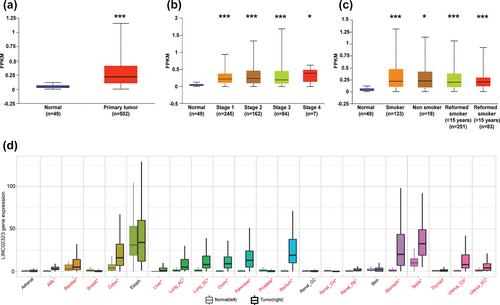
Correlation between LINC02323 expression and the prognosis of patients with LUSC
Next, we investigated the correlation between LINC02323 expression and overall survival (OS) in the TCGA database. The results indicated that high LINC02323 expression was related to poor survival in LUSC in TCGA database (Figure 2a). These results were validated by data from the KM plotter website (Figure 2b). However, LINC02323 was not correlated with relapse-free survival (RFS) in LUSC (Figure 2c). Disease ontology analysis by ENCORI website also showed that LINC02323 was associated with the occurrence of lung cancer, and also correlated with cell cycle-related oncogenic genes, including E2F (Figure 2d). Pathway analysis also indicated that the targets of LINC02323 were involved in cell cycle regulation, DNA replication and repair, and chromosome maintenance (Figure 2e).
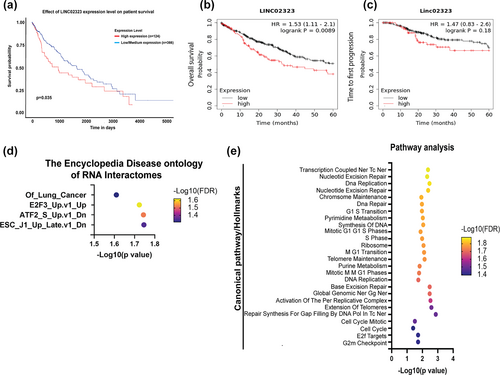
Interactions between LINC02323 with miR-1343-3p/miR-6783-3p-L1CAM axis in LUSC
LncRNAs are known to act as a sponge of miRNAs, thereby inhibiting the degradation of mRNAs targeted by miRNAs. We thus predicted the interactions of LINC02323 using the ENCORI website. The results showed that miR-1343-3p and miR-6783-3p were complementary to LINC02323 (Figure 3a). The levels of miR-1343-3p and miR-6783-3p were higher in LUSC by 3.5- (p-value = 0.031) and 3.84-fold (p-value = 0.0011) compared with these in normal tissues, respectively (Figure 3b, c). However, these two elevated miRNAs had no significant effect on the OS of LUSC patients (Figure 3d, e). We further assessed the potential targets of miR-1343-3p and miR-6783-3p predicted by miRDB (Supporting Information, Table S1, Figure 3f). According to the screening by bioinformatics, L1CAM was the target for both miR-1343-3p and miR-6783-3p, which have high affinity on the binding of 3'UTR of L1CAM (Figure 3g, h). In addition, cross-analysis revealed that the HR of LINC02323 for survival was decreased from 1.6 (with higher level of L1CAM) to 0.64 (with lower level of L1CAM) in LUSC (Figure 3i).
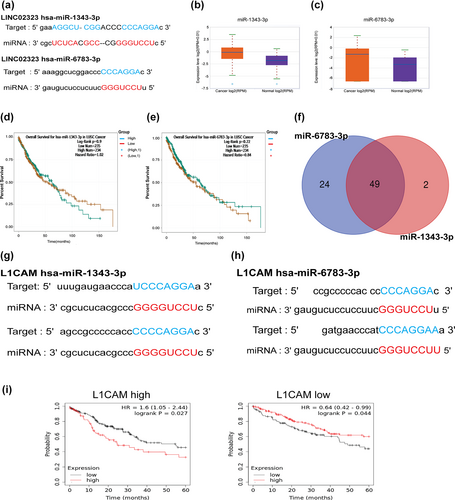
Upregulation of L1CAM conferred poor survival in LUSC
To identify whether L1CAM expression was correlated with LUSC development, we assessed the L1CAM expression in normal and LUSC tumor tissue using a TCGA cohort. The results showed that L1CAM expression was increased (5.01-fold; p-value = 0.0037; FDR = 0.0087) in TCGA cohort (Figure 4a), although expression did not depend on the progress of cancer stages and smoking status in LUSC (Figure 4b, c). The elevated L1CAM was also correlated with poor OS and RFS in patients with LUSC (Figure 4d, e). To elucidate the prognostic value of coexpression gene sets of L1CAM in LUSC development, we extracted the gene sets with a positive correlation of L1CAM in LUSC and assessed by GCSC website. We found that 54 genes (r > 0.3, p < 0.05) were strongly associated with L1CAM expression (Supporting Information, Table S2). The higher GSVA score of this gene set was linked to poor prognosis, including shorter OS (HR = 1.52, p-value = 0.002), PFS (HR = 1.42, p-value = 0.005), and disease-specific survival (DSS) (HR = 1.62, p-value = 0.02), but not disease-free interval (DFI) (HR = 0.71, p-value = 0.19) (Figure 4f–i).
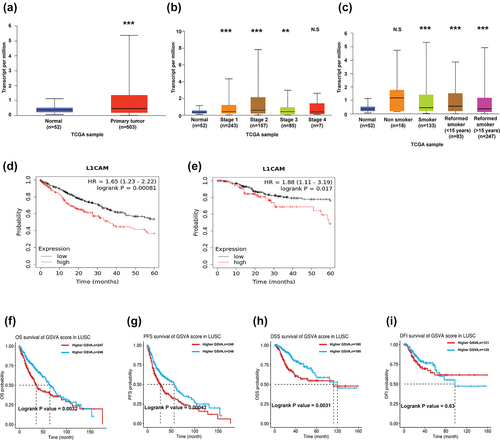
Biological functions of LINC02323
For biological analysis, the gene set which was positively correlated with L1CAM expression had a positive correlation with the epithelial to mesenchymal transition (EMT) and RAS-dependent mitogen-activated protein kinase (RAS/MAPK) pathways (Figure 5a, b). To validate the functional analysis of L1CAM, we also divided LUSC patients in the TCGA cohort into L1CAM higher and lower expression groups, and then applied the gene expression profiles onto GSEA analysis. The results showed that L1CAM and its regulated gene sets in LUSC were mainly involved in collagen formation and FGFR3 activation (Figure 5c, d). KEGG pathway analysis also supported that the gene set was associated with the process of ECM, including focal adhesion, proteoglycans in cancer and ECM-receptor interaction (Figure 5e). The hub genes of the L1CAM-positive gene set were ITGA1, ITGB3, TGFBI, AXL, XDH, PLNCDH3, WNT7A, CHRNB1, and COL17A1 (Figure 5f).

Interaction of LINC02323 with RNA-binding proteins (RBPs)
RBPs are known to be abnormally expressed in cancer and regulate the function of large noncoding RNAs. To better understand the potential regulatory mechanisms of LINC02323 in LUSC, we examined the expression of RBPs, which interacts with LINC02323 in LUSC. We used the ENCORI database to explore possible RBPs for LINC02323. The results showed that 52 RBPs might modulate LINC02323 function. A total of 43 RBPs were upregulated and four RBPs were downregulated in LUSC. Among them, DDX3X expression was reduced and associated with better OS in LUSC. In contrast, the levels of FAM120A, LSM11, and XRN2 were increased and correlated with shorter OS in LUSC (Table 1). To identify the RBP which most probably regulates the LINC02323, we conducted a cross-analysis of LINC02323 with these four RBPs. Cross-analysis of DDX3X with LINC02323 on OS showed that the hazard ratio (HR) of LINC02323 declined in the high DDX3X expression group (HR = 0.74, p = 0.16), compared with that in low DDX3X expression LUSC patients (HR = 1.9, p = 0.0034) (Figure 6a). In contrast, the effect of LINC02323 only slightly, or insignificantly, decreased the OS of LUSC patients with lower expressions of FAM120A, LSM11, and XRN2 in LUSC (Figure 6b–d). These results showed that DDX3X could be a RBP of LINC02323, contributing to the development of LUSC.
| Fold change (tumor/normal) | HR of OS | Fold change (tumor/normal) | HR of OS | ||||||
|---|---|---|---|---|---|---|---|---|---|
| Gene | FC | p-value | HR | p-value | Gene | FC | p-value | HR | p-value |
| AUH | 0.80 | <0.001 | 1.62 | 0.01 | ILF3 | 1.71 | <0.001 | 0.78 | 0.10 |
| BCCIP | 1.63 | <0.001 | 0.62 | 0.04 | KHDRBS1 | 1.36 | <0.001 | 0.78 | 0.11 |
| BUD13 | 1.11 | <0.001 | 0.73 | 0.04 | LIN28B | n.a | 1.20 | 0.23 | |
| CSTF2T | 1.03 | 0.004 | 0.69 | 0.04 | LSM11 | 1.12 | <0.001 | 1.28 | 0.11 |
| DDX3X | 0.87 | 0.001 | 0.85 | 0.27 | NONO | 1.74 | <0.001 | 0.74 | 0.04 |
| DDX42 | 1.18 | <0.001 | 0.86 | 0.34 | NUMA1 | 0.77 | 0.06 | 0.74 | 0.04 |
| DGCR8 | 1.49 | <0.001 | 0.76 | 0.13 | PCBP2 | 1.27 | <0.001 | 0.67 | 0.01 |
| DKC1 | 3.59 | <0.001 | 0.67 | 0.02 | PRPF8 | 0.77 | <0.001 | 1.23 | 0.18 |
| EIF4A3 | 2.21 | <0.001 | 0.81 | 0.17 | PTBP1 | 1.72 | <0.001 | 0.84 | 0.26 |
| EIF4G2 | 1.05 | <0.001 | 1.49 | 0.01 | RBFOX2 | n.a. | 0.75 | 0.05 | |
| FAM120A | 1.18 | <0.001 | 1.27 | 0.15 | RBM27 | 1.09 | 0.006 | 0.74 | 0.05 |
| FBL | 2.85 | <0.001 | 0.72 | 0.03 | SAFB2 | 1.01 | 0.02 | 0.74 | 0.08 |
| FKBP4 | 4.09 | <0.001 | 0.70 | 0.02 | SF3A3 | 1.25 | <0.001 | 0.77 | 0.11 |
| FMR1 | 1.06 | <0.001 | 0.69 | 0.02 | SF3B4 | 1.84 | <0.001 | 0.70 | 0.02 |
| FUS | 1.36 | <0.001 | 0.68 | 0.03 | SLTM | 1.06 | 0.01 | 1.23 | 0.17 |
| FXR1 | 2.61 | <0.001 | 0.71 | 0.02 | SMNDC1 | 1.50 | <0.001 | 0.78 | 0.09 |
| FXR2 | 0.76 | <0.001 | 1.31 | 0.08 | SND1 | 1.33 | <0.001 | 1.26 | 0.19 |
| GTF2F1 | 1.12 | <0.001 | 0.72 | 0.03 | SRSF1 | n.a. | 0.72 | 0.04 | |
| HNRNPA1 | 1.34 | <0.001 | 0.75 | 0.05 | SRSF7 | n.a. | 0.79 | 0.12 | |
| HNRNPC | 1.69 | <0.001 | 0.72 | 0.06 | SRSF9 | n.a. | 0.83 | 0.26 | |
| HNRNPK | 1.50 | <0.001 | 0.78 | 0.10 | TAF15 | 1.27 | <0.001 | 0.88 | 0.42 |
| HNRNPM | 1.34 | <0.001 | 0.73 | 0.03 | TARBP2 | 1.91 | <0.001 | 0.81 | 0.19 |
| HNRNPU | 1.31 | <0.001 | 0.64 | 0.01 | TNRC6A | 1.08 | 0.001 | 0.70 | 0.02 |
| HNRNPUL1 | 1.25 | <0.001 | 0.70 | 0.02 | TRA2A | 1.02 | 0.02 | 0.70 | 0.03 |
| IGF2BP2 | 4.91 | <0.001 | 0.75 | 0.05 | U2AF2 | 1.68 | <0.005 | 0.69 | 0.05 |
| IGF2BP3 | 29.88 | <0.001 | 0.69 | 0.02 | XRN2 | 1.31 | <0.005 | 1.17 | 0.36 |
- Abbreviations: FC, fold change; HR, hazard ratio; n.a., not available; OS, overall survival; RBPs, RNA-binding proteins.
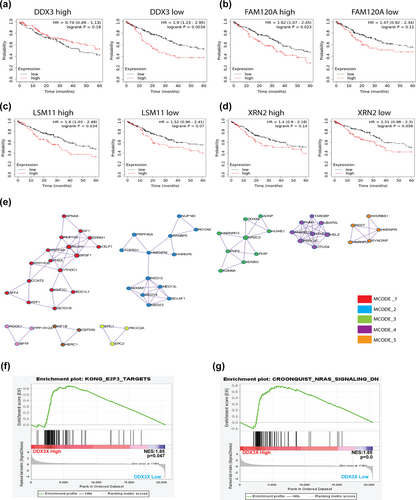
For biological analysis, we extracted the gene sets which were positively correlated with DDX3X expression and assessed it using Metascape. The results showed the gene sets were grouped into functional mcodes, which were involved in RNA splicing, mRNA destabilization and metabolism, histone modification, and stress granule assembly (Figure 6e). In addition, GSEA analysis also supported that DDX3X was associated with E2F targets, as the pathway analysis of LINC02323 (Figure 6f). In addition, the NRAS pathway was also involved in the gene enrichment analysis of DDX3X, as it was in the analysis of L1CAM, a downstream factor of LINC02323 (Figure 6g).
DISCUSSION
Based on the poor outcome, improving the prognosis of LUSC patients by finding novel biomarkers and targets for drug development is urgently required. The association between the dysregulated lncRNAs and the prognosis of patients has been reported in various malignancies.17 Zhang et al. has reported that LINC02323 increased metastasis of LUAD by promoting EMT.18 The correlations of LINC02323 expression have not yet been described in LUSC. In our results, LINC02323 expression was elevated in LUSC tissues. Survival analysis showed that high expression of LINC02323 was positively correlated with the poor prognosis of patients with LUSC. This is the first comprehensive evaluation of LINC02323 that implicates its potential oncogenic role in LUSC.
LncRNAs can act as sponges to regulate gene expression by competitively binding miRNAs.19 LINC02323 as an oncogenic gene has been found in some studies, and it is linked to numerous malignancies, such as ovarian cancer, liver cancer, and LUAD.20 Recent evidence showed that LINC02323 upregulates E2F1 expression by competitively binding to miR-29c-3p, thereby changing the immune microenvironment and chemoresistance in hepatocellular carcinoma (HCC).21 miR-129-5p has also been found to inhibit the proliferation, invasion, and migration of gastric cancer cells by selectively decreasing COL1A1 expression; miR-1343-3p have been indicated to involve LINC02323-mediated cancer growth and progression by suppression of TGF-β receptor in LUAD and ovarian cancer.18, 20 Chen et al. reported that LINC00173.v1 binds to miR-511-5p to regulate VEGFA expression, thereby promoting angiogenesis and development in LUSC. Animal experiments have demonstrated that LINC00173.v1 increases the therapeutic sensitivity of LUSC cells to cisplatin and that targeting LINC00173.v1 could be a potential treatment for combating LUSC. The current study identified two miRNAs, miR-1343-3p and miR-6783-3p, associated with various cancers, including colorectal cancer, glioma, HCC, and LUAD.22-24 Regardless of high expression of miR-1343-3p and miR-6783-3p in LUSC, they were not significantly associated with an OS in LUSC, suggesting the functions of miRNAs were probably via a regulatory network. Indeed, the target gene of miR-1343-3p and miR-6783-3p, of L1 cell adhesion molecule (L1CAM), was upregulated in LUSC and also positively correlated with LINC02323 expression in LUSC (R = 0.18, p < 0.05), supporting the findings that LINC02323 inhibited the function of miR-1343-3p and miR-6783-3p. However, the network of LINC02323-miR-1343-3p and LINC02323-miR-6783-3p interactions warrants further experimental studies in LUSC.
L1CAM is a transmembrane glycoprotein that plays a critical role in cell adhesion, cell migration and cancer development, and is associated with poor prognosis in patients with cancer.25 L1CAM is also regarded as a potential important gene as a predictor of platinum response in high-risk endometrial carcinoma.26 LUAD patients with high L1CAM expression in surgically-resected brain metastases have been reported to have an unfavorable overall survival time.27 Antagonistic mimetic compounds targeting L1CAM decreases glioblastoma cell migration.28 Specifically, increased L1CAM expression has been observed in LUSC patients and has a close correlation with an adverse prognosis in LUSC. Functional enrichment analysis showed that the upregulated genes correlated with L1CAM were primarily implicated in various tumor microenvironment remodeling and growth factor-related pathway, including the EMT process, collagen formation and NRAS pathway. Particularly, the upregulated gene set also predicted an adverse prognosis in LUSC patients, including OS, PRF, and DSS. Additional studies and clinical trials are needed to evaluate whether L1CAM blockade may have significant therapeutic efficacy to improve the treatment of LUSC.
LncRNAs can specifically bind to RBPs and influence the biological functions of RBPs. Conversely, certain specific RBPs can bind to lncRNAs to influence the function of lncRNAs on the regulation of downstream gene expression. On the other hand, RBPs can also regulate the expression of lncRNAs at the transcriptional level. DDX3X, one of the members of the DEAD-box helicase family, is able to control most stages of RNA metabolism from transcription, splicing, RNA export to translation.29, 30 DDX3X can bind to lncRNA TUG1 and increases the stabilization of Bcl-2-associated athanogene 5.31 LncRNA Rncr4 (retinal noncoding RNA 4) regulates the inhibitory function of DDX3X to mouse retina architecture.32 The role of DDX3X in lung cancer is controversial. DDX3X is the RBP of LINC00673-v4, which promotes LUAD progression by activating the Wnt pathway.33 Inhibition of DDX3X by chemical inhibitor RK-33 has been reported to induce apoptosis and increased radiation sensitivity in LUAD A549 cell and NSCLC H1299 cells.34 In contrast, DDX3X has been reported to be a target of tumor suppressor p53, which enhances the cyclin-dependent kinase inhibitor p21, resulting in cell cycle arrest in lung cancer. Indeed, loss of p53 decreased the expression of DDX3X which in turn contributes to cancer progression and poor patient outcome in NSCLC. Loss of DDX3X decreases E-cadherin expression by MDM2-Slug pathway expression and promotes tumor metastasis.35 The present study revealed that DDX3X could be a RBP of LINC02323 due to the loss of LINC02323 impact on OS in the patient with lower level of DDX3X. Reduced expression of DDX3X predicts adverse outcomes and is related to a poor prognosis in patients with LUSC. The consistency between upregulated LINC02323 and downregulated DDX3X was associated with E2F targets and cell cycle regulation, indicating a negative feedback existed between LINC02323 and DDX3X. However, research on the impact of LINC02323 on the biological function of DDX3X is still limited, and further exploration of the associated regulatory mechanism is required.
The limitations of our study are as follows: Biological experiments are required to confirm our results because the study was based on a bioinformatic analysis, and the characteristic details (age, race, tumor grade, size, and therapy) were not taken into account due to our study mainly concentrating on the genes and those commonly identified as significantly changed in TCGA datasets. Therefore, biological information may be needed for further validation.
This study found that the LINC002323-miR-1343/6783-3p-L1CAM and LINC02323-DDX3X axis might be the critical network for determining important molecular mechanisms in the progression of LUSC and they might be valuable prognostic markers and potential therapeutic targets in the progression of LUSC.
AUTHORS' CONTRIBUTIONS
KLW and JYH conceptualized the entire study. YCH, YYW, and CYC provided the technical support, performed the experiments and acquired the data. CYC provided the software management and analyzed the data. YWL and YCH validated the results. YMT and YCH executed the formal analysis. JYH pursued the investigation and provided the resources. YMT, KLW, and JYH performed data curation and interpreted the data. YMT and KLW wrote original draft. JYH and YLH wrote, reviewed and edited the final manuscript. JYH supervised the study, was the project administrator and acquired the funding. All authors read and confirmed the final version of the manuscript.
ACKNOWLEDGMENTS
The authors would like to thank the Center for Research Resources and Development at Kaohsiung Medical University for their technical support. The genetic expression analyses are in whole or part based upon data generated by the TCGA Research Network: https://www.cancer.gov/tcga. The authors would like to acknowledge the investigators of TCGA Research Network.
CONFLICT OF INTEREST
The authors declare that they have no competing interests.
Open Research
DATA AVAILABILITY STATEMENT
Datasets of the present study are not available in public based on some ongoing studies in our laboratory. However, it is available from the corresponding author on reasonable request.



